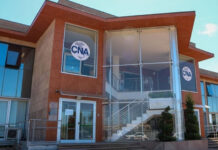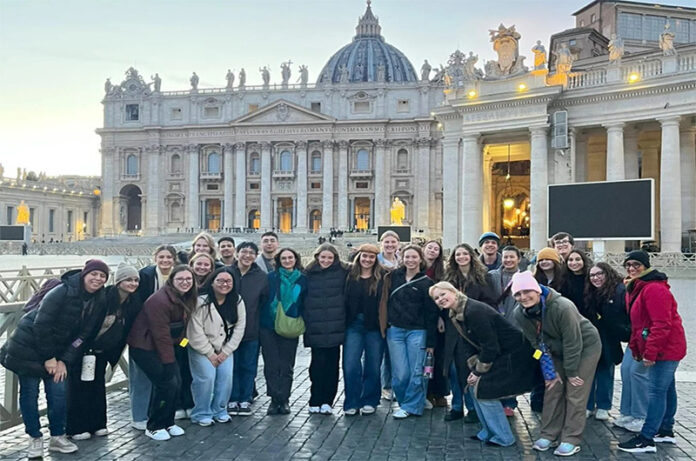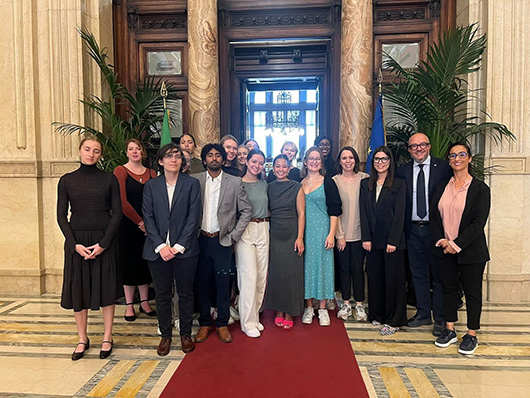Francesca del Giudice, Director of USAC Viterbo, Guides American Students in Discovering Italy and the Hidden Treasures of Tuscia
Going down from the side steps of the Auditorium at the University of Tuscia complex in Santa Maria in Gradi, and climbing the iron staircase, just off the small hallway to the right, you’ll find the world of USAC Viterbo. There to greet us is the Program Director, Dr. Francesca del Giudice, who welcomes us warmly into her world. In the adjoining room is Dr. Luisa Quatrini, the Program Coordinator. Together, they enrich the semester experience for American students in the heart of Tuscia, offering them a unique opportunity to meet people from different cultures and form bonds that last well beyond their time abroad.
The campus is located within the ancient convent complex of the University of Tuscia, a charming setting dominated by the large cloister, which has become the meeting point, exchange hub, and integration space for all university and USAC students.
Let’s Start with a Bit of History to Better Understand the Journey…
Opened in 2006, USAC Viterbo boasts a long history of academic excellence and has often been recognized as one of the best schools in Italy for its study abroad experience. The school offers an informal, flexible, and dynamic learning environment that fosters creativity and interaction among students.
We asked her how this truly unique experience began…
“It all started with the decision to open the second USAC program in Italy. At the time, it was a significant step, while today USAC boasts four programs in Italy and over 50 programs worldwide. Returning to the university environment and working with American college students in the study abroad context fascinated me because it offered an opportunity to create a cultural bridge between two different yet complementary academic worlds. It’s always inspiring to see students grow not only academically but also personally, thanks to the exposure to a new culture”.
Students at USAC Viterbo enjoy an extraordinary experience. Can you tell us about the activities organized for them?
“Certainly, students have the chance to live an extraordinary experience, immersed not only in their studies but also in the cultural and social life of the city. Courses range from art and history, Italian language and culture, to subjects like political science and Italian cuisine, taking advantage of the rich natural context of Tuscia”.
Beyond classes, students actively participate in a variety of extracurricular activities. They can engage in hands-on workshops, guided tours of historical sites, cultural events, and meetings with local artisans. Additionally, through volunteer projects, collaborations with local associations, and exchanges with Italian students, they enrich their experience in Viterbo”.
So, does this create real integration with the local community?
“Absolutely. Most students live in private apartments, some shared with Italian students. A small group opts for a more immersive experience by staying with local host families, forming connections and friendships that often continue long after the USAC experience”.
How do they integrate into the local community?
“Over the years, we’ve had the opportunity to deepen our ties with the local community through volunteer projects and internships in collaboration with local organizations. This responds to the students’ desire to experience the host culture in a direct and authentic way”.
Italian is the fifth most studied language in the USA, where USAC students come from.
“At USAC Viterbo, students are required to enroll in an Italian language course during the academic year. Immersion in the local context is considered essential for an authentic experience, and learning the language is the first step in this direction”.
Moreover, USAC Viterbo has been recognized by an international study abroad review site as the best program for language immersion in Italy. This prestigious recognition highlights the unique value of our program, offering genuine contact with the local community and a truly immersive experience”.
How is the academic semester structured?
“The USAC program in Viterbo is organized into an academic year welcoming four distinct groups of students, from September to August. The Fall group arrives in September and finishes in December. The Spring group arrives in January and stays until mid-May”.
Summer is divided into two short sessions, each lasting about five weeks, from late May to August. These summer sessions offer an intensive opportunity for students to continue their studies in an immersive setting. All groups focus on taking university exams, learning Italian, and integrating into the local community”.
USAC in Italy is present in four cities: Turin, Viterbo, Reggio Emilia, and Verona. Why these cities?
“USAC chose these locations to offer students authentic and accessible study abroad experiences, away from the usual tourist circuits, while ensuring a high academic level and affordable living costs”.
What makes Viterbo unique?
“Viterbo is an ideal choice due to its balance of authenticity, natural beauty, and proximity to Rome, one of the most culturally rich cities in Italy. Nestled in the heart of Tuscia, a historical region rooted in Etruscan civilization, Viterbo offers a peaceful yet vibrant environment surrounded by scenic landscapes, from green hills to charming medieval villages”.
The natural setting, with its hot springs, mountain trails, and proximity to historical sites like Lake Bolsena, makes Viterbo perfect for students seeking cultural and natural immersion, away from the hustle and bustle of larger cities”.
How do students adapt to life in a small medieval town like Viterbo?
“Our students come from both large cities and smaller towns in the U.S. In either case, they find comfort in living abroad in a smaller, more intimate community where it’s easier to adapt, create new routines, and blend into the local context”.
Are the students welcomed by the Viterbo community?
“We’ve always encountered a positive attitude toward our students. Local partners, including schools, families, and university students, consistently provide positive feedback. Sometimes, a little help is needed to overcome language and cultural barriers, but the city is increasingly open and willing to engage in dialogue with others”.
What do they appreciate most about local customs?
“One of their first stops is often the local hot springs, where they enjoy relaxing baths. The local food always leaves a lasting impression, from their favorite gelato shop to the best pizzeria. They also fully engage in local festivities, such as the ‘Macchina di Santa Rosa’ – a massive structure carried through the city’s streets – which captivates and deeply involves them as enthusiastic spectators.They are also fascinated by our lifestyle, sometimes less hectic, and the habit of walking instead of driving, leaving a positive impression on their imagination”.
Which project has given you the greatest satisfaction, and what’s your dream for the future?
“Witnessing their growth shows just how impactful this experience is, and that’s my greatest reward. My dream is to continue influencing students’ growth positively, encouraging them to become active global citizens. Creating opportunities for them to interact with peers from diverse cultural backgrounds enriches the collective experience, benefiting everyone”.
Ph Visit to the Italian Parliament
Ph cover: Rome St. Peter’s Opening of the Holy Door 2025





























